I've been fighting this for the last 5 days and getting desperate.
At first this appears to be a simple grounding/interference issue but for the life of me can't find where that issue is coming from.
I've gone through the power from outlet to pci slot.
Checked all ground potentials, used a physically separate power circuit (with nothing else on it), emi/rfi filters, checked ac voltages, looked at all voltages and grounds on an oscilloscope for obvious noise and difference in ground potentials.
Tried shielding the card, changed cables, used an isolation transformer on the video, TBC, different motherboard, PSU, case, unplugged case fans (as a test), different video card, unplugged all unecessary peripherals.
Checked the NTSC signal on the scope while both plugged into the capture card and to a monitor.
Tried 4 different video sources and now 5 capture devices.
Even internally generated video (avisynth colorbars) from the video card to the capture card exhibits the same symptoms.
I have a JVC monitor with passthru capability and when the video source is plugged in it looks fine.
When the passthru is plugged into the capture card, a dark band appears between the green and violet bars.
This is the same as when the source is plugged directly in to the capture card.
The amplitude is unstable and as you can see, there are artifacts between the bars (especially green/violet) when plugged into the capture card.
Here are some examples -
The original capture prior to all of the above: junk.avi (Huffyuv 33MB)
A current capture: cb2osp-c1.avi.avi (Huffyuv 26MB)
A snapshot from the current capture:
Any ideas?? I'm just about fresh out of them.
+ Reply to Thread
Results 1 to 30 of 36
-
-
Sorry, no ideas. But you didn't really say which video card? I see a Matrox APVe listed in your computer details.
-
part of your problem maybe cuase by dot crawl which in turn mybe cuasing a color shift
-
Sorry, the video capture cards are (Osprey and ATI not installed at the same time)
Capture Board #1: Osprey 210
Capture Board #2: ATI TV Wonder Pro
Capture Board #3: Matrox APVe
I've also tried replacing the APVe with an Nvidia 6100 Fanless just to make sure it wasn't interfering somehow.
Current motherboard is an ASUS P5k Deluxe, E6600, and a PnC 610 PSU. -
The dark vertical line between the colorbars is because the luminance levels in the second video are so different from the first.
After adjusting the luminance levels in AVISynth (I didn't get it exactly right) you can see that the dark bars are about the same. On top is the first video, bottom the second (scaled so the bar widths match):

I used ColorYUV(off_y=55, cont_y=75) in AVISynth, you can fine tune it for a closer match. Actually, it's best if you tune you capture process so you have the right levels to start with.
The little squares are normal NTSC dot crawl:
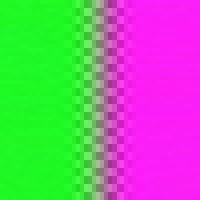
Are you using a composite cable somewhere in the chain? -
In my opinion the problem may be RFI from your computer. Your attempt to shield the card may be inadequate. This is one of the advantages of a USB based external capture device.
Overall, RFI problems are more common in home-built computers. There are FCC standards for external radiation which factory built machines are tested to meet. No one tests the final configuration of a home-built machine. Internal RFI interfereence is possible with many add in cards, even in factory built machines.
Try another computer. -
To help clarify, the first video was before trying all of the steps to try to cure it. The second is where I'm at now.
The samples are from composite in/outs but have also tried Y/C with the same results.
Technically have tried a different computer by replacing motherboard, cpu, psu, case, but again it is a homebuilt.
The RFI Shielding I'm using was salvaged from an old IBM RS/6000 which uses a sheet of copper sandwich between non-conductive material. I tied it to the backplane, but will try screwing it to the card bracket itself.
Will also try the BT8x8 tweaker accessible in VirtualDub capture with the Osprey card. -
You can use TComb(mode=0) to remove the dot crawl. Before and after tComb(mode=0), 4x enlargement:
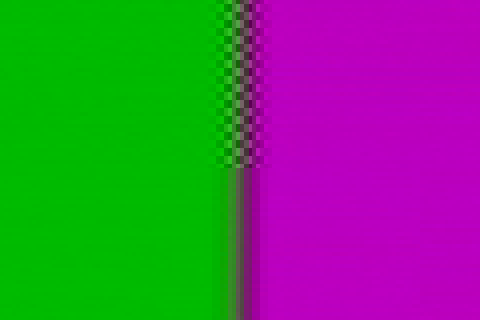
The dark band between colors is normal when RGB is blurred (as happens when you pass through an analog stage). Top half sharp, bottom half blurred:
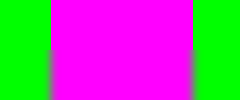
Consider a sharp transition from RGB 0,255,0 (green) to 255,0,255 (magenta). When blurred you may get a pixel halfway between the two colors: 127,127,127. That gray pixel will be noticeably darker than the green and magenta to either side. -
Thanks, that's all good information and appreciate it.
While the dot crawl and artifacts due to capture is somewhat of a known quantity as to their origins, the distortion of the source signal when plugged into a capture device isn't (or shouldn't be.. right?).
So what's happening to the signal before being captured.
I mentioned a test with a JVC monitor.
I put the monitor inline between the source and capture card. With just the source, the color bars are fine, no distortions, no dark band, consistent luminance.
Once the capture card is plugged in (and yes, the terminations are correct on the monitor) the signal is distorted in the same way it is as when the source is being plugged directly to the capture card.
The dark band and inconsistent luminance appears in the source and viewed on the source monitor when plugged into the capture cards (either of the capture cards I mentioned above). -
I'm not sure what you are describing.
So you have a source computer with s-video out. It is connected to a monitor with s-video in and the picture on that monitor is "normal":Originally Posted by Signal
Source Computer >----s-video----> Monitor
And presumably, you have a VGA/DVI monitor attached to the source computer and the picture is normal there?
Is the computer running in "theater" mode or mirror mode? Say the desktop is running at 1024x768 and you open the video test pattern video in Windows Media Player and leave it running in a window. Does the picture on the monitor connected to the s-video cable show only the video test pattern (theater mode) or does it show the entire desktop (mirror mode)?
By this you mean you attach a capture card to the monitor using the monitor's passthrough connector:Originally Posted by Signal
Source Computer >----s-video----> Monitor >----s-video----> Capture Card
Is the capture card in a different computer or the same computer? Are you saying the picture on the Monitor in the middle is now different than it was in the first test? Are you saying the picture on the source computer is now different? And/or the picture viewed in the capturing software on the capturing computer is different? -
Signal,
I suggest you read about comb filters and NTSC artifacts. Your first picture suggests composite NTSC at some point in your process.
http://members.aol.com/ajaynejr/vidcomb.htmRecommends: Kiva.org - Loans that change lives.
http://www.kiva.org/about -
As a test I tried several sources with the JVC monitor inline to the capture card.Originally Posted by jagabo
The first thing to do was to hook up the source to the JVC to simply verify how the source signal "looks".
Source Video >---- Composite or Y/C -----> JVC Monitor.
In these particular tests, the colorbars are generated on a ADVC110 (either powered by wall adapter or firewire from the same computer) or from a Matrox APVe using AVI Synth colorbars. I had to give back a test pattern generator I borrowed, but it didn't fair any better. Looking at burning a test pattern on DVD as a third source.
I'm using a feature of the Matrox APVe which outputs any YUY2 colorspace overlay to the composite/s-video out of the APVe and isn't part of the desktop. Theater mode and mirroring doesn't come into play here.Originally Posted by jagabo
The output is full screen with no issues when viewed directly on the JVC
Correct, but also note I'm using other video sources as part of the test.Originally Posted by jagabo
In the case of the source coming from the APVe, yes it's the same computer but see the same "problem" when the ADVC110 is being used as a source for colorbars.Is the capture card in a different computer or the same computer?
Yes, as soon as the capture card is plugged in, the dark band appears and luminance varies slightly at random and can be seen on the JVC monitor.Are you saying the picture on the Monitor in the middle is now different than it was in the first test?
The monitor being in series could be blamed but the point is this is what I see when capturing directly.
No, I don't see any changes of the source video when being generated from the computer (not sure how that would happen in my case).Are you saying the picture on the source computer is now different? And/or the picture viewed in the capturing software on the capturing computer is different?
If I were to play out of the APVe to the capture card, what's viewed is a nice clean colorbar pattern on the "player" and the issues appear on the capture.
And again, thanks to everyone on the chroma pointers but still think I have an issue with the source signal being dragged down by the capture cards. Even a video isolation transformer isn't helping. -
I have an APVE too. For those who don't know ATI's Theater Mode is the same thing as Matrox's PureVideo/DVDMax mode. I forget what nVidia calls it but they have a similar feature.
OK, to simplify, let's look at one case but keep in mind other variations lead to the same problems:
You have an ADVC110 generating the test pattern and you have connected that directly to a monitor with an s-video cable. That gives you a "clean" picture. You then connect a capture card to the monitor's s-video output (passthru) and the picture on the monitor changes. The dark strip between the green and magenta colorbars gets darker and "luminance varies slightly at random". Do you mean the general static noise in the image? The sparkly noise (dot crawl) at the junction of the color bars? Does the picture get darker overall? Does it flicker?
One of your samples, enlarged and contrast stretched to accentuate the noise:

My first thought was this was a impedance problem. If the s-video passthrough is unbuffered (ie, it's just a Y adaptor), Plugging the capture card in is adding a second load to the source. This could explain a drop in brightness on the monitor. It could exacerbate the dark stripe between the green and magenta bars (by further bluring the image or just overall darkening). I don't think it can explain the sudden appearance of dot crawl artifacts or flickering.
RF noise wouldn't cause the dot crawl artifacts. It could explain the static type noise over the entire image. Although the amount that I see in the samples doesn't look excessive for an unfiltered analog capture.
What exactly where the differences between the two AVI files you posted? Was one from the capture card connected directly to the ADVC100? The other with the monitor in the middle? The luminance levels were very different between the two. -
Thanks jagabo, I agree.. one thing at a time.
[press pause]... [edit] alright.. I'm wrong.. I originally said there wasn't a dark band here but I'm mistaken.. there is a very light one. I'll still try to get some before after pics [press play]...Originally Posted by jagabo
The static noise is what I'm refering to as "luminance varies slightly at random" (It's what kicked off this whole trek). There is no flicker or your "standard" ground loop noise that I can see and dot crawl is the least of my worries right now.[edit: appears] and "luminance varies slightly at random". Do you mean the general static noise in the image? The sparkly noise (dot crawl) at the junction of the color bars? Does the picture get darker overall? Does it flicker?
Agree about the impedance/signal drive problem but don't understand why it is happening when directly going from source to capture card.My first thought was this was a impedance problem. If the s-video passthrough is unbuffered (ie, it's just a Y adaptor), Plugging the capture card in is adding a second load to the source. This could explain a drop in brightness on the monitor. It could exacerbate the dark stripe between the green and magenta bars (by further bluring the image or just overall darkening). I don't think it can explain the sudden appearance of dot crawl artifacts or flickering.
I realize that putting the monitor in the middle can add to the problem and only did that as a test to see what's happening to the signal. Looking at it on an oscilloscope wasn't conclusive as the voltage peaks seem to be in order (1.1v p-p) but as it isn't a regular oscilloscope scope I don't have the option to monitor a single line of video so I can't see the relatively small variances there.
I don't think it's a true hardwired Y that's happening in the monitor as so called production monitors tend to not be designed that way. But yes, agree some degradation of the signal would be expected. I just didn't expect something so drastic. As another quick test going from Source->JVC->Sony Monitor the picture still looks great. Only when the signal is terminated to the capture card does the dark band appear and the static noise start (either with or without the JVC).
Again, I'll try to get some pics.
The first AVI was on my original system before testing everything I could and tearing everything apart and building up a new system from scratch. The second is on the current system. Both are ADVC to an osprey 210.RF noise wouldn't cause the dot crawl artifacts. It could explain the static type noise over the entire image. Although the amount that I see in the samples doesn't look excessive for an unfiltered analog capture.
What exactly where the differences between the two AVI files you posted? Was one from the capture card connected directly to the ADVC100? The other with the monitor in the middle? The luminance levels were very different between the two.
You can get a better idea of the noise by using Virtualdub and Trevlac's colortools filter.
You can even use this viewing a live capture window in Virtualdub by doing the following:
1. Use Preview mode
2. Preview acceleration mode on (using both fields)
3. Make sure RGB Filtering is selected
4. Add Trevlac's colortools filter
5. Configure the filter (use the histogram with no history)
Again, I'll see if I can get some more pics of what's going on.
I'm currently resurrecting an old rig that I used to use with a Matrox RT2500 (long been sold) to see if I get different results on that system. If it's RF than it's more than likely coming from the current and previous MB itself (both ASUS) and also likely showing up on the voltages/ground on the board which shielding of the card wouldn't help. I have tried really hard to verify that isn't the case with the scope and by checking the grounds. -
Quick update - I'm still struggling to get good before/after pics with my digital camera of a tube monitor.
Here's a quick before shot --> before1.jpg
I know it's dark but didn't want to make it worse by trying to modify it further.
The light magenta band goes dark/black when plugged into the capture card as you can see in the other examples.
The revived old system (Tyan Tiger MPX) is actually showing some decent results. I don't have the issue with the signal going to heck but still experience the static noise.. going to try to get that DVD done to at least have another video source to try. -
Looking at the photo of your monitor, I think you may have a problem before plugging in the capture card! Notice how the magenta bar gets brighter just after the transition from green to magenta. This indicates the color components have been shifted to the left relative to the luma component. The green bar has a higher luminance than the magenta bar. If the color components are shifted to the left, the color will change before the luminance does -- exactly what your are seeing.
It would be an interesting experiment to reverse the color bars. If the chroma channels are shifted to the right, reversing the color bars should create a dark band at the transition. I guess you can't do that with the ADVC110 but you can use the TV out from the APVE.
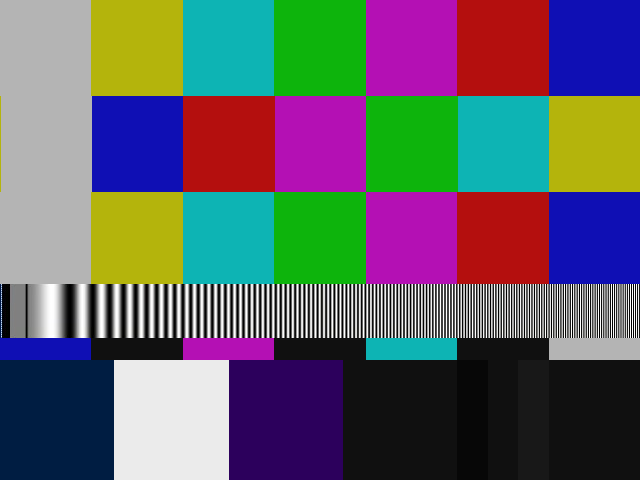
-
Wow.. Interesting discovery there.
I'll go over the tests again as I've been spending some late night hours on this and want to again make sure what I'm saying is correct.
Guess as I now have two systems for testing in the mix I should give them some designation:
1. New ASUS
2. Old Tyan
I'm making a short 5 minute DVD with colorbars generated by AVISynth with the following built in command:
I'll also add your sample pic there and a colorbar flip of the about every 5 seconds or so (think that should be a decent enough delay?).Code:ColorBars(width=720,height=480,pixel_type="YUY2")
-
Swapping between the two patterns should work. I'm looking forward to seeing what you find.
Here's a frame output from my old Matrox G450 card, captured from my PVR250 via composite:
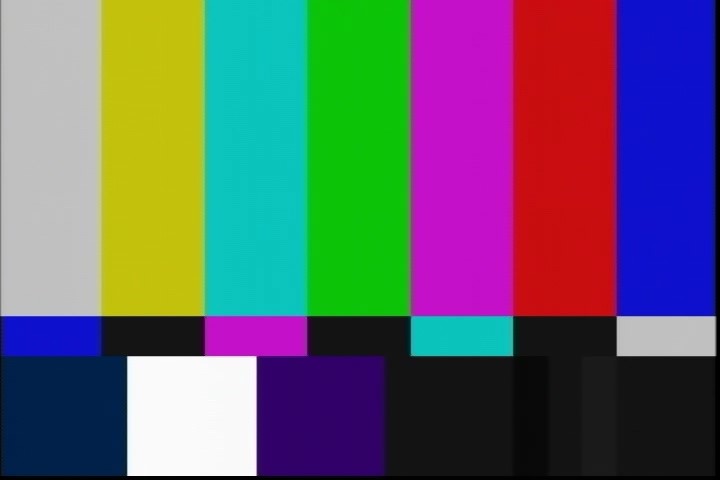
It has the same dark stripe as your samples. I always see the dark stripe between the green and magenta bars. In captures and on TV, with composite or with s-video cables. -
Redoing the original tests all on s-video I found:
1. ADVC -> JVC = dark band (as you expected)
2. ADVC -> JVC -> New ASUS w/ Osprey (system not powered on) = light band (i.e. my example pic of the monitor)
3. ADVC -> Monitor -> New ASUS (powered on) = much darker and somewhat wider dark band / static noise
I just got the DVD burned and trying the same tests with that on both systems so hope to have some new snapshots soon. -
Apologize for the delay.. Here are some snapshots as promised.
I ditched the JVC monitor tests as it wasn't practicle to use for any real analysis and couldn't get any decent snapshots without the camera itself causing distortions.
Unless otherwise noted, these were captured via S-Video from a DVD player on the ASUS system.
1. Jagabo's Sample pic (captured)

2. Same PIC output from the APVe and captured on S-Video (AVISynth Imagesource):

3. These are exaggerated examples of the noise:
Source is generated by avisynth colorbars, burned to dvd, and captured via s-video.
The comparison is then done by AVISynth's histogram(mode="luma") function.
ASUS:

Tyan:

If you look at the two you'll see that the ASUS has some diagonal noise that the Tyan doesn't.
You can download this clip to see it better: cb-noise-osp-asus-2.avi (Huffyuv 48MB)
As you can see the speed of the diagonal movement varies but at times it appears "motionless" in longer clips (a harmonic?). I still suspect a ground issue of some sort on the ASUS.
At this stage I've pretty much gone through everything and being as thorough as possible on that system. The only thing from the original system left component wise is the hard drives and video cards.
I'm more than happy to preclude the ASUS system from being used for capture at this stage just to move on with life.
However the horizontal line variances that exist on both systems is what I'm seeing on all the capture devices I have (internal and external) and have tried quite a few sources. This is even if the frame is a still (i.e. CAV or Digital Freeze Frame from LD, Colorbar generator, DVD freeze frame, output from the same or other computer, etc).
Is this really normal and what is the acceptable level of the change that should be expected? -
One note: in the first picture "Jagabo's sample pic" there is already a bunch of noise. Is that the wrong picture maybe?
Your noise is a bit heavy. Here's an I frame and a B frame from my Matrox G450 captured by my Hauppauge PVR-250, same histogram(mode="luma") function:
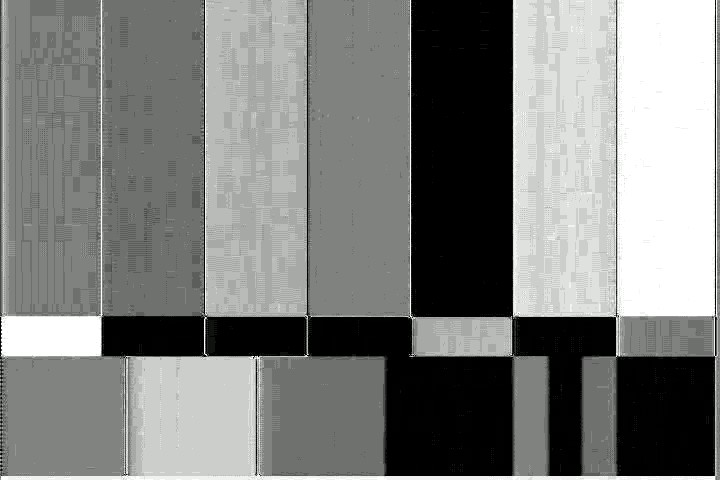
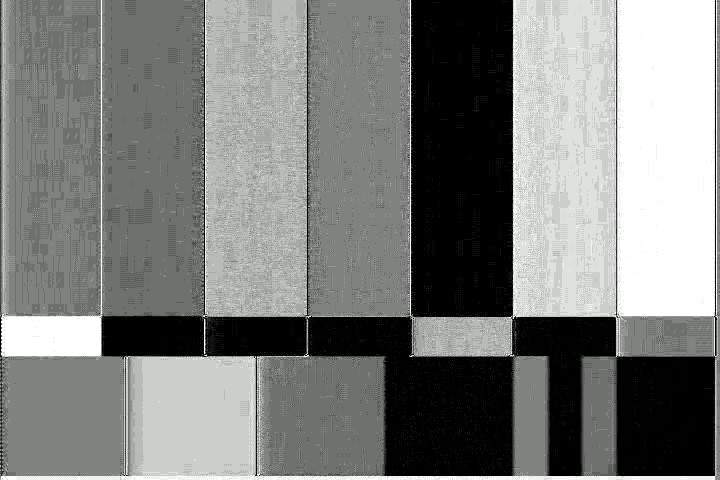
Of course the PVR-250 is a hardware MPEG capture card so you see MPEG macroblocking and DCT artifacts. I disabled all the filtering I could so I think those are as close to the "raw" data as possible.
I suppose you've tried the obvious -- moving the capture card to different slots, as far away as possible from the graphics card is usually best.
By the way, in the midst of all this I found a nice scope pluging for AVISynth: VideoScope. It can be found at the AVISynth download page:
http://avisynth.org/warpenterprises/
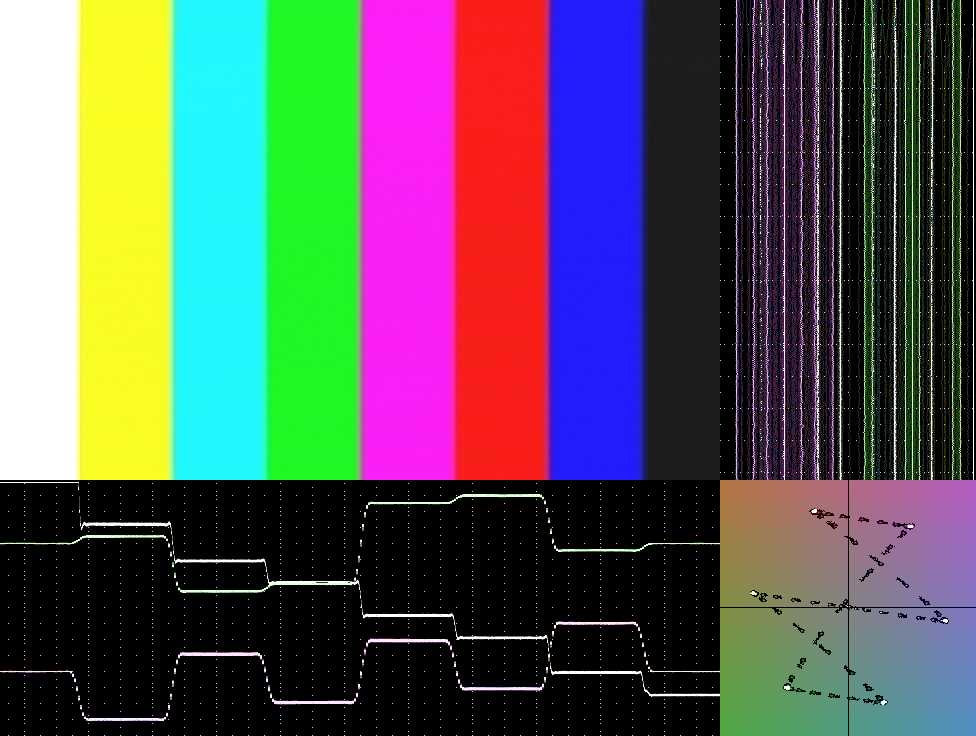
-
It was burned to dvd then captured via s-video - didn't think we needed to post the original again.Originally Posted by jagabo
Out of curiosity what conexant chip is the PVR-250 using?
Doing a quick search I couldn't tell by the photos or datasheets.
I thought there was an MPEG on/off function in VDub Capture when I used my ATI TV Wonder Pro.. I need to look at that.
Yep. That's where it is installed. I even reversed the APVe and the Osprey as I have two PCIe slots and with the Osprey close to the CPU the interference wasn't any better or worse. I've given up on the ASUS for now.I suppose you've tried the obvious -- moving the capture card to different slots, as far away as possible from the graphics card is usually best.
Thanks for the AVISynth videoscope tip.
I was using Trevlac's colortools filter in VDub as you can view the histograms and scopes with a live video feed.
But you can't view everything at once so the videoscope plugin will come in handy.
I'd still like to find some more answers on the horizontal line noise as that's what's common amongst everything I have. 10 video sources (some battery powered), different computers, different source material, and add a Matrox RTX100, ADVC110 external, and generic BT878 card to the list of capture devices. -
I see, the first pic was captured from a DVD player, the second from the APVE.Originally Posted by Signal
I'm out of ideas. -
I believe my PVR-250 is the one with the Philips SAA7115 and Conexant CX23416.
-
What confuses me is this only seems to effect luma (i.e. brightness) only in the horizontal domain (i.e. a single line at a time).
I realize that some quantity of "noise" is going to occur based on source and accuracy (i.e. how well the design) of the ADC is.
What's acceptable seems to be a matter of opinion.
In my case I started down this path because I could see the variances on the capture but not in the raw input and didn't think everyone else had such a problem. It helped discover a problem in the ASUS (now out of action for capture) but still see it on other systems and devices.
Yes, they could possibly be filtered out but I'm still a believer in starting with the best source and capture possible before going that route.
AVISynth's histogram luma mode unfortunately doesn't quantize the amount of variance, only that one did occur. So a 1 vs. 16 luma variance will display the same in the output.
I'd still like to find a way to see how "bad" this really is by highlighting or discovering the major differences in luma per line. It would also help discover how much filtering is really needed. -
To some extent you can see the noise with VideoScope. A thin line indicates little noise, a thick line indicates more:

I used a 16 line tall crop to reduce the area over which the noise is integrated. You can crop down to a single horizontal line.
AVISynth's Histogram("LEVELS") shows it too -- little noise, thin peaks. Lots of noise, fat peaks. -
We looked at histogram luma mode in avisynth and while that's a good indication of noise in general it couldn't distinguish between a 1 pixel luma variance versus a 10.
Using levels can be a bit of a problem if you want to see patterns of noise in the frame. Something I'm finding useful.
So with some help I was able to get some avisynth scripts for showing groups or individual variances of luma between frames.
I'm working on tuning and colorizing them and hope to get these in a more useful format to share.
So far I found some interesting items (to me).
The ASUS sample has a 1 to 7 luma variance.
The Tyan has a 1 to 14 variance.
The luma variance is always a loss rather than a gain/loss scenario.
You can also see this in the black areas where no luma gain between frames exist and are noise free.
This kind of surprised me as you would think the kind of noise we are talking about here should affect the black levels if it were on the source side of the circuit. -
I've been at this since my last post and still haven't found an answer.

I haven't gotten too fancy with the following Avisynth script, but it does break out the noise into individual luma variances. This is intended to be used with a static non-moving image (i.e. a test pattern or frame still).
Note: Requires Mask Tools 2.0 for Avisyth found here: masktools-v2.0a31.zip
My source is Huffyuv or uncompressed, but it is required to be converted to YV12 for histogram and mt_lutxy to work.Code:# luma_diff.avs # Show differences in luma between frames. # Designed to be used with a capture of a static image (i.e. a test pattern) tclip="testpattern1.avi" # Change this to your avi testclip tframes=150 # Number of frames per test function lut_comp(clip test1, string low, string high) { test2=test1.trim(1,test1.framecount) lut_exp = "x y - abs "+low+" < 0 x y - abs "+high+" > 0 255 ? ?" return mt_lutxy(test1, test2, lut_exp, y=3, u=-128, v=-128) } testclip=AviSource(tclip, audio=false).trim(0,tframes).ConvertToYV12() orig=testclip.subtitle(tclip+" - "+string(tframes)+" Frames - ConvertToYV12") histoluma=histogram(testclip, mode="luma").subtitle(tclip + " - Histogram mode=luma") lutdiff1=lut_comp(testclip, "1", "1").subtitle(tclip+" - Luma Difference of 1") lutdiff2=lut_comp(testclip, "2", "2").subtitle(tclip+" - Luma Difference of 2") lutdiff3=lut_comp(testclip, "3", "3").subtitle(tclip+" - Luma Difference of 3") lutdiff4=lut_comp(testclip, "4", "4").subtitle(tclip+" - Luma Difference of 4") lutdiff550=lut_comp(testclip, "5", "50").subtitle(tclip+" - Luma Difference of 5 to 50") AlignedSplice(orig, histoluma, lutdiff1, lutdiff2, lutdiff3, lutdiff4, lutdiff550)
I'm now exclusively working on the luma side by using s-video to BNC breakout cables and using just the "Y" side.
My current victim board is a Blackmagic Decklink HD Extreme PCIe set to use Y/C inputs.
Here is the test pattern I'm working with now.
640x480 png version

720x480 png version here
Bigger width and fewer steps in order to see them better on a scope.
I wanted to go over the test pattern generation again before posting some samples from the Blackmagic card.
I had to remove the Matrox APVe due to Blackmagic strongly listing it as an incompatible card with their product.
I didn't even bother trying them together as I have enough going on with this issue.
I've been converting test images to DVD and using that as a test source due to a lack of a decent test pattern generator. The player is a Yamaha DV-S5950.
I now have a Nvidia 8600GT installed but can't get the TV Out to work as I'd like. I can't get full screen or proper alignment and have also tried a 640x480 of the pattern as well.
If anyone has any suggestions on how to get that test image out correctly on a Nvidia card I would appreciate it.
Also would appreciate if someone could post some sample captures with that test image.
Thanks. -
I just changed motherboards and temporarily have a cheap ATI card for video output. Nothing is calibrated for this card yet. Here's an 8 Mb/s cap via my Hauppauge WinTV PVR-250 (noise filters off, no sharpening) directly from the graphics card (in the same computer) via composite.
eight.mpg
Similar Threads
-
Hi8 capture- Suggestions for Harddrives and Capture Cards?
By CMP1223 in forum Capturing and VCRReplies: 7Last Post: 11th Jun 2011, 00:05 -
capture cards 360
By ihazcheezburga in forum Capturing and VCRReplies: 2Last Post: 19th Feb 2011, 20:14 -
What's new in capture cards for VHS capture?
By chowmein in forum Capturing and VCRReplies: 21Last Post: 29th Jul 2010, 09:03 -
Using 2 Hauppauge Capture Cards
By ddpool58 in forum Capturing and VCRReplies: 35Last Post: 21st Aug 2009, 22:53 -
Help with Video/Capture Cards.
By drsimp12 in forum Newbie / General discussionsReplies: 4Last Post: 7th Nov 2007, 07:05



![Computer details: Win7 x64 Ultimate
Intel i7 980ex
Gigabyte X58A-UD3R rev2.0
Nvidia 9600GT
6GB DDR3 @ 1600
x2 600GB Velociraptor - Intel RAID 0
x1 1.5TB [backup drive]
x1 100GB SSD [OS and Applications] Comp](/images/buttons/computer.gif)

 Quote
Quote